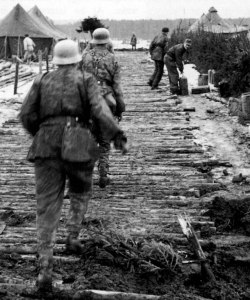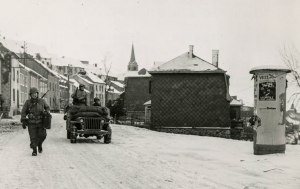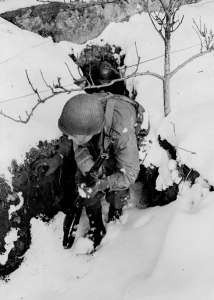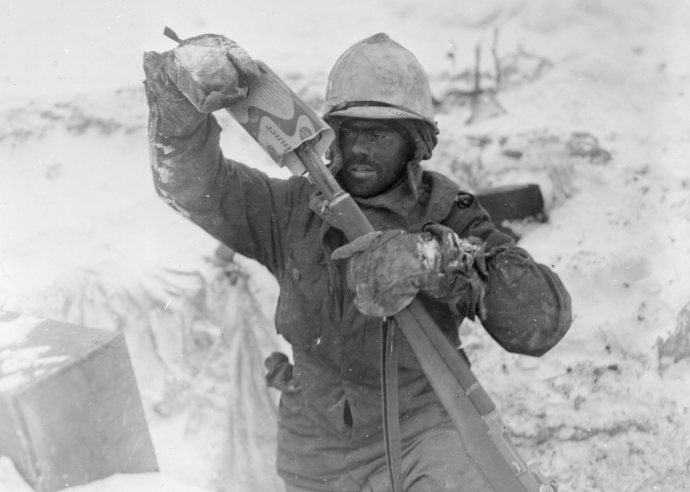John Buford’s Ghost:
Day One in the Ardennes
 In mid-December 1944, Lieutenant Colonel Robert E. O’Brian Jr. had a hunch. As commander of the 38th Cavalry Reconnaissance Squadron, he’d been tasked with defending the ancient city of Monschau, which served as an important part of the local road network. One north-south road passed through town, intersecting with an eastward running route that could take the traveler to Rohren (still held by the Germans) or southeast to Hofen and the 3rd Battalion, 395th Infantry.
In mid-December 1944, Lieutenant Colonel Robert E. O’Brian Jr. had a hunch. As commander of the 38th Cavalry Reconnaissance Squadron, he’d been tasked with defending the ancient city of Monschau, which served as an important part of the local road network. One north-south road passed through town, intersecting with an eastward running route that could take the traveler to Rohren (still held by the Germans) or southeast to Hofen and the 3rd Battalion, 395th Infantry.
O’Brian held an important part of the line, and his hunch led him to believe that the Germans might counter-attack him. As a result, in the final days before Watch on the Rhine began, he kept his troopers busy digging trenches, clearing fields of fire, laying mines and trip flares. He brought in eighty truck loads of barbed wire and made sure that all of his platoons and troops were wired in tight. For additional support, he placed a platoon of tank destroyers to overwatch the main roads leading into town. His M5 Stuart light tank company covered the town itself and the route leading east, while his troopers dug in on the hills and slopes east of town, scraping their fighting positions out of hip-deep snow and frozen ground in places. The work was hard and rugged, but O’Brian’s men would be prepared. On the night of December 15, 1944, his troopers hunkered down in their holes, waiting to see if the squadron commander’s hunch would play out.

The venerable M5 Stuart light tank served throughout the campaign in Western Europe despite being undergunned and vulnerable to German anti-tank fire. This one belonged the 3rd Armored Division, and the crew is watching a German air attack on December 18, 1944, two days into the Battle of the Bulge.
Across No-Man’s Land, the men of Sepp Dietrich’s Sixth SS Army made their final preparations for Operation Watch on the Rhine.
Sepp Dietrich was a street fighter. An NCO during World War I, he returned home and embraced the chaos of post-war Germany. He became one of the earliest Nazi adherents, and one of Hitler’s oldest confederates. As a combat leader, he was despised and derided by the blue-blooded Prussian elite that formed the nexus of the Werhmacht’s officer corps. They thought he owed his position entirely to his relationship with Hitler, and that anyone with his luddite level of intelligence was best left in the NCO corps, not commanding entire SS armies. Perhaps so, but the fact was Dietrich commanded almost reverence among his men. Time and again, he inspired them with his front-line example as well as his refusal to live better than they did. He shared their hardships and privations, and the Waffen-SS soldiers loved him for it.
But by 1944, Dietrich’s heart wasn’t in it anymore. After Normandy, he knew the war was lost, and Hitler’s insistence to continue it only got more of his men killed. After learning of Operation Watch on the Rhine that fall, he approached the Ardennes counter-offensive with a very pessimistic view of how things would go.
He was not disappointed.
The Sixth SS Army was supposed to attack after a heavy initial bombardment along a front that ranged from about ten miles north of Monschau south to the Losheim Gap. The terrain here was low and swampy—impossible tank country. Behind and to the south of Monschau stretched the high ground of the Elsenborn Ridge. That ridge was the key to the Sixth SS’s initial attack. Take it, and the roads to the south the panzers needed to get to the Meuse would be opened up. The Sixth SS Army had been assigned five main roads that would hopefully carry the panzers west to the Meuse River. Taking Elsenborn Ridge would open up three of those five routes to the river.
Dietrich assigned his LXVII Corps to launch the initial attack around Monschau. This would be the hinge of the entire Sixth SS Army’s assault, and was designed to protect the right flank of Dietrich’s main effort.
Originally, it was supposed to be carried out by the 272nd and 326th Volksgrenadier Divisions, supported by a battalion of behemoth Jagdtiger tank destroyers. Fate threw the first curveball of the game, though, when the Jagdtigers failed to arrive before December 16th. They’d been loaded aboard trains and sent forward. On the way, Allied fighter bombers shot up the tracks. The Jagdtigers could not get forward in time to support the initial blows. The volksgrenadiers would make their attack unsupported.
The LXVII Corps faced another problem on the morning of the 16th. The Americans had been driving forward with the 2nd, 9th, 78th and part of the 99th Infantry Division right on the north side of the Ardennes, intending to grab the Roer River dams before Christmas. Three days before the offensive’s scheduled start, the 272nd Volksgrenadier divisions had been sucked into a furious house-to-house urban battle in Kesternich. Part of the 326th had to actually go and reinforce it, which bled away much of the corps’ initial strength in its own assault.
None of this mattered to the men in the frozen foxholes east of Monschau when the first German shells began to fall at 0530. All up and down the ninety miles Ardennes front line, over a thousand German guns roared to life. Everything from mortars to 14 inch naval guns rained high explosive death down on the American positions. Within minutes, the shells severed most of the communication lines that ran between the front line units and their headquarters, or the artillery units. )
Twenty minutes later, at Monschau, Sepp Dietrich’s Volksgrenadiers padded across the snow-covered forested hills and slammed into O’Brian’s defenses. The American cav troopers were waiting, virtually unscathed by the opening bombardment thanks to their defensive preparations. In fact, O’Brian had ordered wire parties out to restore communications with their assigned field artillery battalions in the rear before the barrage had even ended.

Lightly armed and equipped, the cav units in the Ardennes faced overwhelming odds in the first days of the Battle of the Bulge. These troopers belonged to the 28th Cav and are seen in Wiltz, Luxemburg later on during the battle.
They had not yet finished repairing the lines when the first Volksgrenadiers from the 751st Regiment slipped into view. If the 38th Cav folded, V Corps headquarters would be vulnerable to an attack from the rear and flank. It was a seminal moment for the American cavalry, and like General John Buford’s troopers on Gettyburg’s Seminary Ridge two generations before, they more than rose to the challenge.
The first wave of Germans reached the outskirts of Monschau and ran right into the waiting M5 Stuarts from F Company. The tankers loaded their guns with 37mm canister shells, and when they opened fire, the massed effect of these gigantic shotgun-like blasts tore apart an entire Volksgrenadier company. The survivors recoiled as their comrades, so vibrant a moment before, lay in gruesome horror around them. They left behind at least fifty, probably more like seventy-five dead and dying men.
The 38th Cav suffered seven casualties. Sepp Dietrich’s far north assault had failed completely.
A few miles to the south, the 99th Infantry Division’s 3-395 had weathered a dreadful barrage that saw at least two hundred and fifty shells land in the battalion’s area of operations around Hofen. At ten minutes to six, the 2nd Battalion, 751st Volksgrenadiers, 326th VG Division charged through the morning fog across broken terrain and hit the 3-395 Infantry at five points almost simultaneously. The German main effort slammed into the junction between I and K Companies, which happened to be just east of Hofen. Without communications re-established with the artillery units in the rear, the battle that unfolded here pit a green U.S. infantry battalion against a green German Volksgrenadier Division.
The Volksgrenadiers surged for the American lines and ran straight into point-blank small arms fire. Some of the U.S. BAR men held their fire until the Germans were not even ten feet away from their camouflaged foxholes. The dead heaped around these positions, and some of the stricken grenadiers actually tumbled into the BAR men’s foxholes. Mortars shells fell and machine guns unleashed their fearsome destructiveness, and the grenadiers died in the snow. The attack continued, but each successive rush was stopped by American gunfire.
At 0650, an hour after the attack began, the battalion restored communication with the artillery units I the rear. Within minutes, the forward observers in the trenches called down hell itself on the Germans. Multiple battalions of 105mm howitzers and the massive 155mm Long Tom cannons joined the battle.
The grenadiers attacked with desperate bravery, and in some places they made it through the curtain of artillery to battle the Americans with bayonets and butt stocks. The men of the 3-395 held firm, refusing to be driven from their foxholes even as heaps of German dead piled around them. By 0745, the attack had failed. Almost half the 2nd Battlion, 751st Grenadiers lay dead or dying in the snow. 
As the grenadiers withdrew and regrouped, they left behind over a hundred and fifty wounded men. Some lay as close as two hundred feet from 3-395’s foxholes. Throughout the day, they groaned, and cried out in agony, unable to move. In places, the lesser wounded men scrabbled through the snow to give what succor they could to their dying comrades. Here and there, a German medic would brave American fire to rush forward, administer some morphine and first aid. But there weren’t enough brave medics that day, and by nightfall, the moans and pleas grew steadily weaker. By morning, the battlefield was silent; the wounded had frozen to death.
Excerpted from my book:




